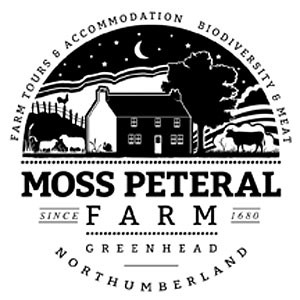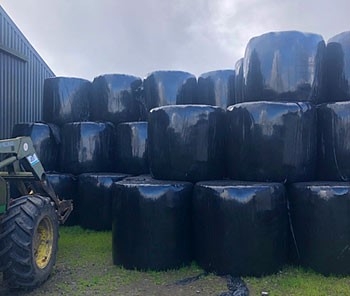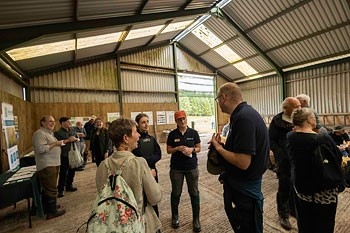
Moss Peteral Farm

Moss Peteral Farm
It's not been an easy summer. There have been dry days but not lots in a row. We cut grass hoping to make hay in the middle of August but after a couple of days drying, in the face of a dismal forecast, we had it wrapped in plastic. Hay bales of damp grass will go mouldy and could be a fire risk whilst damp grass wrapped in plastic 'cures' rather than rots. It's known as haylage and is a good quality feed for livestock - but we'd rather have saved the financial and environmental cost of plastic wrap.
Over the last few years we've gradually increased cattle numbers and decreased sheep aiming to better control some of the rougher grasses which sheep find unpalatable. We often graze the animals together and this helps to lessen intestinal worm infections in the lambs. We submitted faecal samples from our lambs, pre and post weaning, to the vets this year. In both instances the worm egg count was satisfyingly below the threshold at which treatment is recommended.

Hay bales at Moss Peteral Farm.
For a decade now we've reared the turkeys, from day old, in a stone-built, earth-floored outbuilding. One morning in August we found 15 dead birds with barely a mark on them. The remaining 100, thankfully, looked perfectly healthy. A close examination found the dead birds had all been bitten on the neck We suspected a stoat, moved the remaining birds elsewhere and set up a trap. We failed to catch anything so borrowed a camera, but the only animal we captured on that was a hedgehog... The identity of the culprit, stoat, polecat and mink are all possible candidates, remains a mystery. The live turkeys appear happy with the new accommodation and are growing well.
We welcome help with turkey plucking and reward volunteers with a free bird. Do contact me if this exchange appeals to you.
I missed the Missing Lynx exhibition at The Sill earlier in the year but was visited a couple of weeks ago by Faye, a researcher, to find out what I knew about the cat and my views on living with lynx in the area.
The adjacent Wark Forest has been identified as the most feasible reintroduction site in England. The project's website https://www.missinglynxproject.org.uk/ demonstrates a balanced approach, considering the science, technology, culture, economics and law, of any future reintroduction.
The Great North Bog Day at the end of July was very successful. The speakers; Ella from The Peat Partnership, Ian from Curlew LIFE, John from Northumberland Wildlife Trust, Meg Rogers & Bill Burston, all demonstrated their knowledge and enthusiasm making for lively discussions and informative workshops. We immediately received requests to repeat next year! We'd certainly be up for hosting and hope that Wilder Northumberland will be able to coordinate - and fund! - again.

The Great North Bog Day, Moss Peteral Farm.
I was hoping to be able to report that peat blocking work had started and tree whips ordered for planting this winter. Unfortunately the peat work has been delayed by contractor's staff issues and the grant application for the new woodland remains somewhere in a Forestry England officer's in-tray... However 180m of Stewardship funded dry stone wall has been masterfully rebuilt by Ben and Johnny Lloyd.
Visits to the farm are available over the winter. We've enjoyed hosting DEFRA policy makers, delegates to the National National Parks conference, North Pennines smallholders, a U3A group, Girl Guides, and learning disabled adults from a horticultural skills project... Who's next?